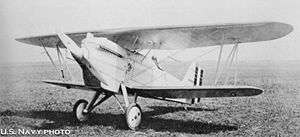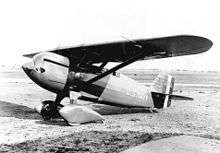Curtiss F6C Hawk
The Curtiss F6C Hawk was a late 1920s American naval biplane fighter aircraft. It was part of the long line of Curtiss Hawk airplanes built by the Curtiss Aeroplane and Motor Company for the American military.
| F6C Hawk | |
|---|---|
 | |
| Curtiss F6C-1 - Model 34 | |
| Role | Carrier-borne or land-based fighter |
| Manufacturer | Curtiss Aeroplane and Motor Company |
| Introduction | 1925 |
| Primary users | United States Navy United States Marine Corps |
| Produced | 1927 |
| Number built | 75 |
Originally designed for land-based use, the Model 34C was virtually identical to the P-1 Hawk in United States Army Air Corps service. The United States Navy ordered nine, but starting with the sixth example, they were strengthened for carrier-borne operations and redesignated Model 34D. Flown from the carriers Langley and Lexington from 1927–30, most of the later variants passed to Marine fighter-bomber units, while a few were flown for a time as twin-float seaplanes.
Operators
Variants


- F6C-1 Model 34C virtually identical to the P-1 series.
- F6C-2 Model 34D strengthened for carrierborne operations and fitted with arrester hooks.
- F6C-3 Model 34E modified version of the F6C-2.
- XF6C-4 Model 34H prototype F6C-1 with a Pratt & Whitney R-1340 Wasp radial engine.
- F6C-4 Model 34H production version of the XF6C-4.
- XF6C-5 Model 34H prototype F6C-1 with a Pratt & Whitney R-1690 Hornet radial of 525 hp (391 kW).
- F6C-6 Model 34E modified for racing, with its radiator located inside the fuselage.
- XF6C-6 Model 34E the F6C-6 which had won the 1930 Curtiss Marine Trophy was converted to parasol-wing monoplane configuration and given wing surface radiators; after achieving the fastest lap in the 1930 Thompson Trophy race the XF6C-6 crashed when its pilot was overcome by fumes.[1]
- XF6C-7 Model 34H testbed for an experimental 350 hp (260 kW) Ranger SGV-770C-1 air-cooled inverted Vee engine.
Specifications (F6C-4)

Data from United States Navy Aircraft since 1911
General characteristics
- Crew: 1
- Length: 22 ft 6 in (6.86 m)
- Wingspan: 37 ft 6 in (11.43 m)
- Height: 10 ft 11 in (3.33 m)
- Wing area: 252 sq ft (23.4 m2)
- Airfoil: Clark Y[3]
- Empty weight: 1,980 lb (898 kg)
- Max takeoff weight: 3,171 lb (1,438 kg)
- Powerplant: 1 × Pratt & Whitney R-1340 Wasp 9-cylinder air-cooled radial piston engine, 410 hp (310 kW)
- Propellers: 2-bladed metal propeller
Performance
- Maximum speed: 155 mph (249 km/h, 135 kn) at sea level
- Range: 360 mi (580 km, 310 nmi)
- Service ceiling: 22,900 ft (7,000 m)
- Time to altitude: 5,000 ft (1,500 m) in 2 minutes 30 seconds
Armament
- Guns: 2 × fixed .30 in (7.62 mm) Browning machine guns in the forward fuselage
References
| Wikimedia Commons has media related to Curtiss F6C Hawk. |
- Pearce, William. "Curtiss XF6C-6 Navy Racer". oldmachinepress.com. Retrieved 17 May 2016.
- Lednicer, David. "The Incomplete Guide to Airfoil Usage". m-selig.ae.illinois.edu. Retrieved 16 April 2019.
- Eden, Paul and Soph Moeng. The complete Encyclopedia of World Aircraft. London:Amber Books, 2002.
- Swanborough, Gordon and Peter M. Bowers. United States Navy Aircraft since 1911. London:Putnam, Second edition, 1976. ISBN 0-370-10054-9.